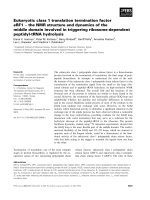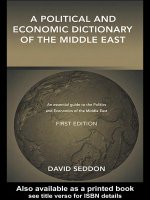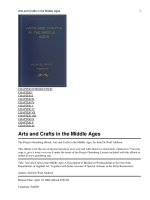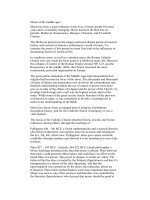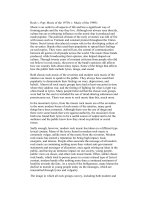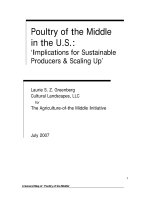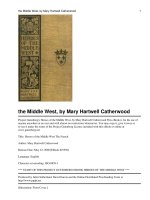music of the middle ages
Bạn đang xem bản rút gọn của tài liệu. Xem và tải ngay bản đầy đủ của tài liệu tại đây (50.27 KB, 6 trang )
Music of the middle ages
Music has been a great influence in the lives of many people for many
years and is constantly changing. Music has been divided into six
periods: Medieval, Renaissance, Baroque, Classical, and Twentieth
Century.
The Medieval period was the longest and most distant period of musical
history and consists of almost a millennium’s worth of music. To
examine the music of this period we must first look at the influences or
dominating factors of medieval life.
In a political sense, as well as a spiritual sense, the Roman Catholic
Church was very much the focal point of a Medieval man's life. Between
the collapse of control of the Roman Empire around 500 A.D. and the
Renaissance in the middle 1400s, the Church remained the most
continuously powerful organization in Europe.
The great gothic cathedrals of the Middle Ages help demonstrate how
religion had become the focus of the times. The thousands and thousands
of hours of labour, the tremendous cost involved, the extraordinary and
detailed craftsmanship without the use of cranes or power tools must
give us an idea of the effects of religion and the power of the Church. To
worship God through one's craft was the highest artistic ideal of the
times. While some of the great secular classic literature of the past was
well known to many, it was considered to be only a teaching tool to
assist in the understanding of the Bible.
Music has always been an integral part of religious celebrations
throughout history, and for the Catholic Church of antiquity, it was a
vital element.
The music of the Catholic Church absorbed Greek, Jewish, and Syrian
influences among others, through the teachings of :
Pythagoras 6th – 5th BCE, a Greek mathematician and a musical theorist
who believed that there were perfect intervals in music and introduced
the 8ve, 5th, 4th, whole tone. Pythagoras’ ideas gave music scientific
credibility through numbers and allowed it to be introduced as one of the
sciences.
Plato 427 – 347 BCE / Aristotle 384-322 BCE, Greek philosopher’s
whose teachings introduced the idea that music is ethical. Plato believed
that music could generate ethical space and could have an effect on the
moral fibre of a person. The power to cleanse, to create an ‘ethos’. He
believed that the idea is created by the thinkers (Speclatores) and that it’s
interpretation is a mirror of the idea (Speclum), and that the
representation was carried out by the doers, the musicians, artists etc
(Cantores). Plato believed that thinkers were more important than doers.
Music was seen as one of the sciences and therefore was controlled by
the theorists (Speculatores) who decreed that music should be good to
transmit good things lest it should introduce impure thoughts. Music in
it’s most superior form could not be heard. Only by mirroring
(Speculum) could it be heard.
Aristoxenus 375 BCE, student of Xenophilus and Aristotle researched
pitch, intervals, scales, keys, modulation and constructed melodies. He
introduced the Tetrachord (4-note). Aristoxenus wrote books on both
listening to and making music and playing instruments. He examined the
nature of rhythm (strong vs weak) and supported division into 3 as
perfect, and into 2 as imperfect using Pythagoras’ ideas on number
perfection.
Emperor Constantine 306 – 337 AD, became the emperor of Rome in
306, and was the most powerful person in his part of the world. His
conversion to Christianity had far reaching effects on the common
practice of the religion and on all the factions of Christianity that are
present today. His conversion happened during a war with his
brother-in-law and co-emperor, Maxentius. According to the historian
Eusebius , Bishop of Caesarea in Palestine, before the crucial battle of
Milvian Bridge, Constantine was convinced that he needed divine
assistance. While he was praying for such assistance, God sent him a
vision of a cross of light at midday, bearing the inscription "in hoc signo
vinces " ("in this sign you will be victorious"). That night he had a dream
that reaffirmed his earlier vision. God told him to use the sign he had
been given as a safeguard in all of his battles. Thus, Constantine
converted to Christianity and ordered the symbol of his Savior's name
(the intersection of the Greek letter chi and rho) to represent his army.
Constantine was victorious in the battle of the Milvian Bridge, and he
continued to wear the symbol for Christ against every hostile power he
faced.
At around 350 AD, the Schola Cantorum (singing school) was founded.
This was an idea picked up from the Jewish synagogues where the
Levittes had special training and took on the role of temple musicians.
St Augustine of Hippo 354-430 AD, was a very influential and great
philosopher/theologian. Saint Augustine is one of the most important of
the Latin Church Fathers. His works, especially his De Musica,
Confessions and City of God, helped distinguish the Church in Western
Europe from the Church as it developed elsewhere. He decreed that
music should not be too tuneful and that there should be no
metre/rhythm, which led to church leaders being beset by fears of
musical pleasures and thus continuing the ideas of the Greek
Philosophers. “I wept at the beauty of your hymns and the canticles…the
sounds poured into my ears and the truth distilled in my heart”-from
Confessions. This encapsulates the feeling and mood of the church at this
time – that the ‘bad’ feelings produced by the music had to be distilled.
A preference for sacred vocal music was developed and pagan secular
music and instruments were rejected. Instruments were not appropriate
because of the links with pagan rituals and Roman arenas. Ambrose,
Bishop of Milan introduced hymn singing. The hymn, St. Ambrosia, is a
tuneful/ornate link with secular music.
Justinian I was crowned in 527. Up until this time pagan rituals, statues
and temples still existed. Justinian decreed that the studying of all pagan
beliefs should be outlawed. Latin was firmly established as the language
of the church.
Also around this time St. Benedict founded the Benedictine Rule at
Monte Casino. Monasteries were established all over Europe and the
Benedictines become very powerful and influential people.
The leaders of the Church decided to organise and codify the thousands
of pieces of music used in worship. Gregory I, Pope from 590 to 604, is
usually given the credit for getting the effort started.
Codified all the church chants (Antiphonar) and set course to make the
Roman Rite pre-eminent across western Europe using Gregorian Chant,
the Mass and the Daily (monastic) Office as it’s base. Legend has it that
a Dove from God sat on Gregory’s shoulder and whispered the chants to
him. He founded the Schola Cantorum in Rome.
He produced sacramentary rubrics (red rules), that brought together all
the ideas and formalised the ‘order of services’, Gregory used the first
Canon of Euchology, standardised the chants and started to make use of
the Schola Cantorums. He sent emissaries all over Europe to teach the
Roman style and was responsible (mainly by his promotion by the Franks
300 yrs later through the reign of Charlemagne 768 – 814) for
standardisation of Masses all over Europe. 768 – 814
While some sources suggest that he composed many of the melodies,
there is little to authenticate this. Nevertheless, this music grew to be
called "Gregorian Chant" in his honour.
Prior to around the year 1000 AD, virtually all music, Western music
included, consisted of one dominant, unaccompanied melody line. This
texture, called monophonic still dominates much non-western music
today, including Far Eastern, Indian, and Arabic cultures at least those
that haven't become corrupted by Western practices yet!
Gregorian chant, sometimes known as "plainchant" consists solely of a
melody, sung unaccompanied in Latin, with very free rhythms. It is one
of the few types of music in Western civilisation without a feeling of
meter. Gregorian chant conveys a disembodied, ethereal, spiritual sound,
certainly not focusing on anything that might inspire physical pleasure.
These chants made use of scales other than the major and minor ones
familiar to us. Instead they used the different "modes" such as Dorian,
Phrygian, Lydian, etc.
Starting around the year 1000, the practice of using polyphony began to
enter into Western music. Polyphony is the use of independent lines
within a piece of music. This multi-layered texture gave music a new
expressive intensity, almost literally giving it another dimension. Perhaps
not a coincidence, the use of perspective in painting was evolving at
about the same time, expressing a parallel expansion in the visual
medium. The first polyphony (called 'organum') consisted of two voices
moving in parallel motion. Later as harmony became a little more
sophisticated, the voices began taking on a little more independence
from each other.
Considering all these factors it is not really surprising that the vast
majority of music that survives from the Middle Ages is sacred music.
There are a couple of reasons for this.
Firstly, the key word in the above statement is survives. In European
civilisation following the collapse of the Roman empire, literacy fell to
an all time low during the Middle Ages. Even though modern scholars
are revising their opinions of culture in the Medieval times upward, the
average peasant simply couldn't read or write. That special talent was
passed along by the church through its religious orders.
This included the special talents of reading and writing music. And of
course, the monks whose duty it was to notate and copy music would
have a tremendous bias toward the sacred music.
A second reason is that there really was a great deal of sacred music
composed. Again, it was considered the highest form of art to be able to
use one's talent to praise God. Life had become more and more
dangerous and uncertain for the inhabitant of the Middle Ages. Without
science to illuminate physical laws, without bacteriology to allow the
understanding of diseases and plagues, fear and superstition became the
method of explaining the unknown. Our earthly existence was ultimately
looked upon as a dangerous, misery filled prelude to a blissful afterlife.
The Church represented the hopes of the better world to come.
Sacred music of the Middle Ages centred around two primary areas, the
Office and the Mass. Virtually all sacred music at that time was sung in
Latin.
Monks were expected to sing, pray, and read the scripture eight times
during the day from Matins (just after midnight) to Vespers (just before
the evening meal) and Compline (at dusk). These times were known as
the Hours of the Divine Office.
The most important musical event in the Roman Catholic Liturgy was
the Mass. Wrapped around the sacrament of Holy Communion, the Mass
consisted of two parts called the Ordinary, and the Proper.
The Proper of the Mass was the part that changed from day to day, as the
readings were geared for specific feast days and occasions. The Ordinary
of the Mass was the text that remained consistent throughout the church
year. The five parts of the Ordinary were the ones most commonly set to
music in Medieval and later times.
Below is a list of the parts of the Mass. The parts of the Ordinary are in
bold typeface.
Introit
Kyrie
Gloria
Collects
Epistle
Gradual
Alleluia (or Tract in certain seasons)
Gospel
Credo
Offertory
Preface
Sanctus/Benedictus
Canon
Lord's Prayer
Agnus Dei
Communion
Post Communion prayers
Ite Missa Est
In addition to the regular Mass, a Requiem Mass was a common liturgy.
Meaning "rest", the Requiem Mass was the "Mass for the Dead", used at
funerals.
The earliest settings of this music were strictly monophonic. Through the
Middle Ages, polyphony became an important stylistic element in music.
Not surprisingly, the greatest composers of the time put their best
energies into the mass. "Missa Notre Dame" by Guillaume de Machaut
represented the first polyphonic ordinary done by a single composer.
Leonin, Perotin, Dufay, and Machaut were the leading composers of the
earliest sacred polyphonic music. Many other leading composers of the
Middle Ages remain anonymous this was not yet an age of musical
personalities.
Guido D'Arezzo, a monk who lived in the early 11th century devised a
version of the staff that is the precursor of today's staff. Some of his
practices also contributed to "sight-singing" the reading of music at
sight. He also started the practice of using the Latin syllables of Do, Re,
Mi, Fa, etc. to symbolise pitches.
Travelling minstrel singers, often known as troubadours, trouveres, and
minnesingers, were the secular musicians. Generally their music was a
monophonic line which they accompanied on the lute or harp, probably
using one of the Church modes. These poet/musicians sang of nature, of
love, of knightly legends, and of the sense of the mystical that pervaded
their lives. Mysticism and superstition were the only tools available to
explain the stars, the seasons, the randomness of weather patterns,
diseases, etc and these tools played a great part in the lives of Medieval
citizens as they struggled to understand the world around them.
Common types of secular music were the Rondeau, Virelai, the Frottola
(many of which today we would simply lump under the heading
"ballad"), and the motet. Coming from the French "mot" meaning 'word',
the motet often had several lines of music and text, sung in different
languages. Often the different melodies were on completely different
subjects, occasionally pairing a sacred text with a very bawdy one!

